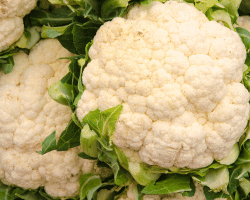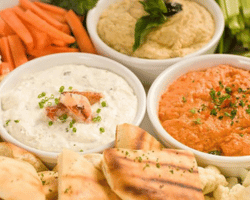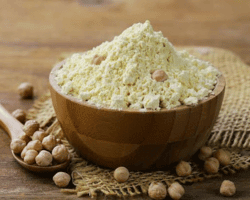If you’re a fan of Asian and Middle Eastern cuisine, you probably familiar with the star ingredient of today’s article.
No matter as a salad, siding, dip, or even roasted; chickpeas are a delicious versatile type of bean highly consumed in worldwide daily life. It is high in proteins and vitamins, which makes it a good addition to vegan diets as a meat replacement.
Also known as garbanzo beans, this legume is famous for its ability to assist the digestive process and reduce diabetes risks. Besides considering the health benefits of chickpeas, it is still worth asking: is it possible for keto dieters who strive to consume nearly zero carbs to include it in their meals? Will it prejudice the losing weight journey?
Are Chickpeas Keto?

Short answer: not quite. When following a ketogenic diet, the last thing you want is to compromise the carb counting.
A single cup of chickpeas is loaded with about 45g of carbs, which is way more than needed on keto. After all, the carb counts must be lower than the fat consumed in a day for a successful ketosis process.
But if you insist on having chickpeas, just be mindful of the portion sizes — although many good chickpea alternatives will satisfy you much more than a measly two tablespoons of this legume.
Read Also:Keto vs. Brain Fog: How the Diet Can Transform Your Mental Clarity
Chickpeas Are Too High in Net Carbs for Keto
Net carbs are the result of the subtraction of the fiber content from its total carbs. This simple calculus gives you a more accurate picture of the carbs that your body will absorb.
For keto dieters, this intake is limited to between 25-50g daily and, unfortunately, cooked chickpeas contain 16.2g net carbs per half-cup serving. It may not sound many things for a regular diet, but for keto, these beans contain much more than the carb limit permits. Besides, it actually can be replaced for much more generous portions of keto-friendly foods — which will give you much more energy and nutrients.
While a cup of zucchini only contains 2.7g net carbs, a cup of chickpeas is equivalent to about twelve cups of zucchini: that’s why it’s generally recommended to avoid this legume when you’re in ketosis.
Cauliflower is a Low-Carb Chickpea Substitute

Even though the quite bland and slightly earthy flavor seems irreplaceable, there are some chickpea alternatives for you to try.
Thankfully for its delicate flavor, cauliflower is a blank canvas that can be the perfect bean replacement in almost every recipe. It has a mild taste and can be chopped up fine to make keto-friendly salads or curries, or processed into dips.
It has fewer carbs than garbanzo beans and is high in dietary fiber. However, unfortunately, it’s also lower in protein than the beans. So, you’ll need to add other protein sources to your meals to meet your daily needs.
Get Creative with Keto-Approved Chickpea Substitutes
Despite the fact that there are fewer keto-friendly alternatives available than in a more adaptable diet plan, it is not necessary to eat the same meal over and over again. By getting creative and learning about different preparations and possibilities, you can explore new foods.
As a result of your choices, the texture of your food will change; try new combinations or recipes slowly over time. If you want to get really creative with these ingredients, consider trying vegan recipes.
Veganism is an extensive movement that includes not only plant-based eating and animal defense. It also extends to finding meat replacements for common non-vegan items such as sausages, hamburgers – even salmon!
Because it’s all homemade, you don’t need to worry so much about additives or preservatives – it’s your own cooking!
Try Plant-Based Proteins as Chickpea Replacements
You still have plenty of swaps left to get your protein without blowing your carb count. Beans are off-limits on keto, but you can turn to plant-based proteins — and we’re not just talking about diced vegetables.
Nuts like almonds or cashews are a good bet; in vegan cooking, they’re often used for their ability to add creaminess to sauces and spreads. Quinoa is another option to consider for salads and grain bowls.
Best Options for Replacing Chickpeas on Keto
There are more options than cauliflower, including beans. So, either if you’re not into this vegetable or you’re simply tired of the bland taste of it in your meals, here we have a list of grains to use instead of chickpeas.
-
- Soybeans
Versatile and suitable for a vegan diet, soybeans have a mild taste but pack a protein punch. Commonly, you can find it on vegan cheese, tofu and tempeh.
The beans’ texture is similar to that of chickpeas, which makes them perfect for substituting in many recipes. Soy is the best bean option you’ll find, as it has just 3.7g net carbs per cup and an impressive 31.3g protein per cup.
-
- Lentils
Similar to beans, lentils also come in various types. Green lentils have a zesty taste and can be effortlessly substituted into salads and herbal spreads. But, unfortunately, they are too high in carbohydrates.
Red lentils are the better option among the others in this category. With just 15g of net carbs per cup, they match green ones for protein. Despite its slightly sweet taste, it works well in soups and salads — or even in purees.
-
- Edamame
Edamame, a popular ingredient in Asian cooking, is simply young green soybeans. Differently from the mature soybeans, these have a creamier texture which makes them a perfect appetizer or snack on their own.
Similar to the mature bean version, edamame has a low carbohydrate content and can be enjoyed while following the keto diet with ease. Each cup contains just 6.4 grams of net carbs – making it an excellent alternative to roasted chickpeas for roasting purposes.
Make Hummus Without Chickpeas for Fewer Carbs

It is hard to imagine a hummus not made from chickpeas since that’s the whole thing. If you’re on a strict keto diet or like to eat more than 2 tablespoons (30 grams) of it at a time, the traditional Middle Eastern dip is likely too high in carbs.
Gladly, it’s not impossible to make it without chickpeas: you can make keto-friendly versions of it that are lower in carbs. To preserve the typical hummus flavor (as we want), we’re not changing the other ingredients besides the protein — garlic, 2 tablespoons of olive oil, lemon juice, and tahini.
-
- Cauliflower
When I said it is a versatile vegetable, it was no hyperbole of mine. The first step is to roast some well-seasoned cauliflower in the oven until you get golden edges. Afterwards, you just need to process it with the other ingredients until nice and smooth — a regular hummus texture.
-
- Artichoke
Not only delicious, artichoke hearts suit perfectly when replacing chickpeas. Its soft and velvety texture brought together with Middle Eastern cuisine brings less carb intake — although not less than cauliflower hummus.
-
- Black soybean
The closest version to the original, it has the exact right texture and it is the most ideal for a keto diet — and I really mean it, we’re talking about 2 net carbs per cup! Pair it with low-carb toast or crunchy veggies like celery, carrots, and bell peppers. Voilá is the perfect snack for your afternoons with no pinch of guilt.
-
- Almond pulp
If you’ve just made homemade almond milk, don’t throw away the pulp! How about making hummus instead? You not only reduce food waste but also get a delicious snack that is a good source of fats for your afternoon.
Chickpeas Have Far More Carbs Than Keto Substitutes
So far, recognizing that chickpeas are too high in carbs might not come exactly as a surprise for you. However, it isn’t the end of the line for you if you are interested in finding low-carb diet substitutes that are equally versatile.
Whether we’re talking about salads, hummus, sides, or even roasted dishes there are a range of foods with similar textures that can make loved recipes without pushing up your carbohydrate intake too far above your limit for the day.

If you haven’t tried using cauliflower or tofu as chickpea substitutes in recipes, maybe you should reflect on the idea. It could save you quite a few carbs — and because the net carbs are so much lower (almost nonexistent for both), you can eat bigger portions with no guilt.
For instance, if you wanted to match the net carb count of one cup of tofu with chickpeas, you’d have to limit yourself to 9.3 grams of garbanzo — and that’s not very many! You wouldn’t feel full after eating them. Besides, they would give you less than half the protein that one cup of tofu would.
So, make sure to choose wisely when planning your daily menus on keto; it can cost you more than carbs.
You Can’t Eat Beans or Chickpeas on the Keto Diet

Just like garbanzo beans, many popular bean varieties have the same issue: being too high in carbs and not very keto-friendly.
Sure, you could add a spoonful or two of these beans, but they won’t satisfy half of your hunger compared to a whole cup of other protein that serves as a chickpea replacement in meals and recipes.
Beans to steer clear of:
-
- Lima beans
Unfortunately, a cup of these beans has around 30g net carbs per cup.
-
- Pinto beans
Consider that they got almost 30g per cup serving size.
-
- Black beans
The carbs of this bean are around only half of the present in garbanzo beans, but is still quite high – 25.8g.
-
- Mung beans
Just like black beans, they contain more fiber than chickpeas. But still having half of the carbs of chickpeas (23.3g).
-
- White beans
Also unsuitable for a ketogenic lifestyle, these have around 32.6g per cup and 16.9g protein.
Enjoy Keto Hummus Recipes With Low-Carb Substitutes

Following a keto diet and having a hankering for something like hummus is no easy feat. And limiting yourself to 30g of it? Talk about unsatisfying.
Instead of dealing with the disappointment of minuscule portions or denying yourself something you enjoy – which, in the worst-case scenario, might just see you break your diet and start binge eating –, consider swapping out the main ingredient for something that works for your plan.
There are plenty of options that can do a decent garbanzo bean impression. With the right seasonings, you might not notice much difference in taste either. The key is keeping certain elements: the faint bitterness of lemon, perhaps; some smokiness courtesy of paprika; chickpea-like smoothness.
You’re probably best off trying different swaps until you find one that comes close enough. Embrace making all the hummus, and exploring new culinary possibilities: this will be more satisfying than nailing it the first time.
Read Also: Unlocking Ketosis: Can a 48-Hour Fast Do the Trick?
How Many Carbs In Chickpea Flour?

Highly consumed mainly for gluten-free-based diets and celiac people, chickpea flour is commonly used in various recipes to substitute wheat flour.
However, this byproduct of garbanzo beans still contains relatively high carbs, with about 53.2 grams per cup if you deduct the fiber. That makes it suitable for a moderate-carb or low-carb diet but not keto since that tops out at a daily carb intake of 50 grams.
Still, if you intend to build muscle or grow and break ketosis, garbanzo bean flour is a great alternative for you.
But consider trying other types of wheat if you’re focused on going low-carb and lose weight. There are some substitutes well-known by keto dieters, such as almond, rice, or coconut flour, and flaxseed or sunflower seed meal.
Frequently Asked Questions(FAQs)
With only 2g net carbs per cup, tofu is the best alternative for chickpeas in recipes such as roasted snacks. Cauliflower is also an option since it is equally low in carbs (5g per cup), but it suits way better than tofu for certain recipes, like hummus.
Soya beans and black soybeans are the ones that have fewer carbs per cup. They nearly have 3 grams of it; besides being really versatile as replacements for chickpeas.
Not really. When you eat hummus on keto, beware of how much you’re consuming at once. Considering 30 grams portions, it contains around 4-8 grams of net carbs per serving.
In order to maintain smaller consuming quantities, enjoy it as a garnish instead of siding or dip. That way, you are still able to eat the original dish without the negative effects of it.
No. Cannellini (also known as white kidney bean) is a type of white bean. They are quite similar in appearance and taste, which makes it easier to substitute one for another in plenty of recipes.
However, as many other bean species, Cannellini has the same problem as garbanzo: they are too high-carb to suit a keto lifestyle.
It’s all a matter of personal choice: sure, you can include high-carb legumes in your diet, but keep in mind that the higher the carb count, the smaller the portion will be. In those cases, it is not worth it to include these foods in your meals, since they won’t satisfy you or provide the necessary nutrients and energy for the day.
It is wiser to add a cup of keto-friendly food to your plate than 10 grams of chickpeas. The nutrient intake will surely be higher.


